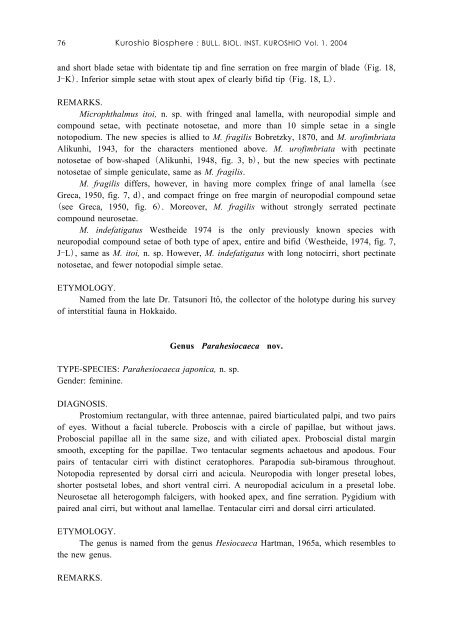HESIONIDAE (ANNELIDA, POLICHAETA) FROM JAPAN. I. by Hiro ...
HESIONIDAE (ANNELIDA, POLICHAETA) FROM JAPAN. I. by Hiro ...
HESIONIDAE (ANNELIDA, POLICHAETA) FROM JAPAN. I. by Hiro ...
Create successful ePaper yourself
Turn your PDF publications into a flip-book with our unique Google optimized e-Paper software.
76 Kuroshio Biosphere : BULL. BIOL. INST. KUROSHIO Vol. 1, 2004<br />
and short blade setae with bidentate tip and fine serration on free margin of blade (Fig. 18,<br />
J-K). Inferior simple setae with stout apex of clearly bifid tip (Fig. 18, L).<br />
REMARKS.<br />
Microphthalmus itoi, n. sp. with fringed anal lamella, with neuropodial simple and<br />
compound setae, with pectinate notosetae, and more than 10 simple setae in a single<br />
notopodium. The new species is allied to M. fragilis Bobretzky, 1870, and M. urofimbriata<br />
Alikunhi, 1943, for the characters mentioned above. M. urofimbriata with pectinate<br />
notosetae of bow-shaped (Alikunhi, 1948, fig. 3, b), but the new species with pectinate<br />
notosetae of simple geniculate, same as M. fragilis.<br />
M. fragilis differs, however, in having more complex fringe of anal lamella (see<br />
Greca, 1950, fig. 7, d), and compact fringe on free margin of neuropodial compound setae<br />
(see Greca, 1950, fig. 6). Moreover, M. fragilis without strongly serrated pectinate<br />
compound neurosetae.<br />
M. indefatigatus Westheide 1974 is the only previously known species with<br />
neuropodial compound setae of both type of apex, entire and bifid (Westheide, 1974, fig. 7,<br />
J-L), same as M. itoi, n. sp. However, M. indefatigatus with long notocirri, short pectinate<br />
notosetae, and fewer notopodial simple setae.<br />
ETYMOLOGY.<br />
Named from the late Dr. Tatsunori Itô, the collector of the holotype during his survey<br />
of interstitial fauna in Hokkaido.<br />
Genus Parahesiocaeca nov.<br />
TYPE-SPECIES: Parahesiocaeca japonica, n. sp.<br />
Gender: feminine.<br />
DIAGNOSIS.<br />
Prostomium rectangular, with three antennae, paired biarticulated palpi, and two pairs<br />
of eyes. Without a facial tubercle. Proboscis with a circle of papillae, but without jaws.<br />
Proboscial papillae all in the same size, and with ciliated apex. Proboscial distal margin<br />
smooth, excepting for the papillae. Two tentacular segments achaetous and apodous. Four<br />
pairs of tentacular cirri with distinct ceratophores. Parapodia sub-biramous throughout.<br />
Notopodia represented <strong>by</strong> dorsal cirri and acicula. Neuropodia with longer presetal lobes,<br />
shorter postsetal lobes, and short ventral cirri. A neuropodial aciculum in a presetal lobe.<br />
Neurosetae all heterogomph falcigers, with hooked apex, and fine serration. Pygidium with<br />
paired anal cirri, but without anal lamellae. Tentacular cirri and dorsal cirri articulated.<br />
ETYMOLOGY.<br />
The genus is named from the genus Hesiocaeca Hartman, 1965a, which resembles to<br />
the new genus.<br />
REMARKS.


